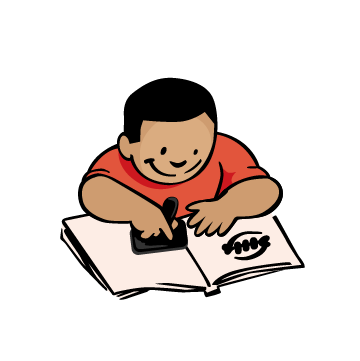Boston Children's Museum
308 Congress Street, Boston, MA 02210
617-426-6500
© Boston Children’s Museum 2025
Website Design by JackrabbitAdinkra are unique symbols created in West Africa, especially in Ghana. They are often used on pottery, woodcarvings, in logos, and they are especially beautiful when stamped on fabric. The Ashanti people of Ghana originally created Adinkra cloth to wear on special occasions, like funerals and weddings, and to important religious ceremonies. Adinkra stamps are symbols that represent specific feelings, events, things, or places.
Print out or draw familiar symbols, as suggested above. Come up with a story of your own to tell with symbols.

Ask your children what a “symbol” is and discuss familiar symbols (for example, a heart is a symbol of love; a red octagon is the symbol for “stop” in this country; the peace symbol is a sign of peace, etc.). What makes a picture a symbol? What is the difference between a picture and a symbol? What are some symbols that everyone knows? Could symbols be used to tell a story? Use a whiteboard or poster paper to brainstorm symbols and have kids help you draw common symbols.
Once you have brainstormed symbols, tell students that in Ghana, a country in West Africa, special symbols called “adinkra” are sometimes stamped onto cloth to honor important occasions. Ask students to find Ghana on a world map if you have one, then show them symbols from the Adinkra Glossary (Click for the PDF). If you have time, read to your kids the Adinkra Story (“Two Crocodiles That Share the Same Stomach”) from this curriculum.
Use symbols to tell a story about an important event in your life.
Once your students have had a chance to recall an event and draw a few symbols, bring the group back together to discuss their work so far. Did everyone think of a special occasion or event? Was it hard to choose one to tell a story about? How are they deciding which symbols to use in their story? Is it hard to tell a story using symbols instead of words or more detail pictures?
Remind your students that in Ghana and some other countries in West Africa, people sometimes use special symbols called adinkra to help tell stories about an event or someone they cared about. Share the Adinkra Glossary (Click for the PDF) if you have made copies, and tell your children that they can use these symbols to help tell their story. Make sure to tell students that these are only a few of the adinkra symbols that exist. If they would like to see more, they can search for them on the Internet. See Suggestions below for resources.
Have students go back to their symbols and finish creating their stories. Then, they can swap with a neighbor or partner and tell that person the story of their special occasion, using the symbol story they’ve created. If you like, have students present their stories to the whole group.